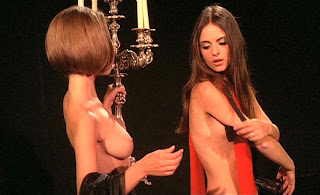
Starring:
Renaud Verley, Viveca Lindfors, Alfredo Mayo, Maribel Martin, Nuria Gimeno
The young Juan (John in the bad
English overdub), a rebellious practical joker with an anti-authoritarian streak
a mile wide, is being released from an asylum. He heads home to seek revenge on
his aunt and three cousins; they had him placed there on false charges so that
they could steal his inheritance after his mother’s death. Juan works in a
slaughterhouse for a while, apparently just long enough to learn a few tricks
about killing animals and preparing corpses. Then he returns to his mother's
home, which has been empty since her death and his imprisonment. He prepares a
series of complex "jokes" as revenge and invites his aunt and cousins
over to see the house, which he has restored to how it looked when he lived
there. Juan prepares to slaughter all four women, partly in revenge and partly
to be free of them, but will he go through with it?
A Bell from Hell is a subversive, surreal, and occasionally funny slice of Eurohorror that must be seen to be believed. It ranks as one of my favorite horror films of all time and there is nothing else quite like it. Much Spanish horror from this period – The House That Screamed, The Blood Spattered Bride, Cannibal Man, Spirit of the Beehive, the works of Jess Franco, and more – is a reaction against the fascist yoke Franco forced upon the country for many years. These films managed to tell subversive, often horrifying stories while avoiding the gaze of fascist censors, but none of them go quite as far as A Bell from Hell. Almost Buñuel-like in its use of humor and surrealism to deliver a scathing indictment of fascism, the combination of practical jokes and violent and/or sexual acts are impressively creative.
This truly singular film has been sadly neglected, but is a fine example of Spanish horror cinema, bearing a close relationship to other darkly surreal works of Franco-era cinema. It is awash with an atmosphere of the Gothic and has numerous Poe references. In many ways, it's kind of a weird horror hybrid of Jean Rollin and Buñuel. There is a dreamy, disturbing atmosphere, as well as an insistently anti-bourgeois flavor.
Much of the film's strength relies on protagonist Juan, who is genuinely likable despite some of the horrible acts he commits. This is, at its core, a revenge film and writer Santiago Moncada (Cut-Throats Nine, All the Colors of the Dark, Hatchet for the Honeymoon) pulls out all the stops to make Juan convincing. He is filled with rage, but also sympathy, and like several other Spanish cinema protagonists of that era, views the world fundamentally differently than those around him. The magical Renaud Verley (The Damned) is perfect as Juan, displaying disgust at some of the things he must do and a genuine doubt as to whether or not he is mad. He is also seemingly the lone voice of reason in a town full of criminals and hypocrites.
Though some of the acting
from the side actors is a little rough, there are fine performances from all
the leads, which include a number of genre regulars. Viveca Lindfors (Creepshow, Frankenstein’s Aunt), Maribel
Martin (Blood Spattered Bride), and
Christina von Blanc (A Virgin Among the
Living Dead) are all beautiful and do their justice to their roles as Juan’s deceitful
relatives. Alfred Mayo (The Hunt)
and Saturno Cerra (Tristana) also make
welcome appearances.
Director Claudio Guerin famously fell from the bell tower on the last day of shooting and died, so the final shots of the film were finished up by Juan Bardem (uncle of actor Javier), who is also responsible for the imaginative editing. This beautiful, haunting film feels a little disjointed, probably because of Guerin's death, but gleefully dives into the unexpected and rips the ending right out from under you. Playfully subversive, Guerin uses the conventions of cinema to fool characters within the plot and viewers (make-up, soundscape, storytelling, etc.).
Director Claudio Guerin famously fell from the bell tower on the last day of shooting and died, so the final shots of the film were finished up by Juan Bardem (uncle of actor Javier), who is also responsible for the imaginative editing. This beautiful, haunting film feels a little disjointed, probably because of Guerin's death, but gleefully dives into the unexpected and rips the ending right out from under you. Playfully subversive, Guerin uses the conventions of cinema to fool characters within the plot and viewers (make-up, soundscape, storytelling, etc.).
Surreal, subversive horror is my favorite kind and A Bell from Hell is
an excellent example of this. It comes with the highest possible recommendation.
Fortunately, it has become easier to find in recent years. It's finally
available on region
1 DVD from Pathfinder, though it's not the completely uncut Spanish version
and suffers from poor dubbing. Hopefully someone will release an uncut, restored Blu-ray version sometime soon.













